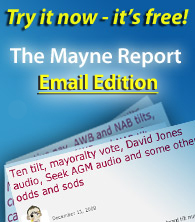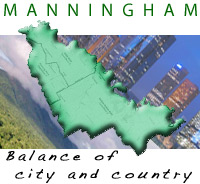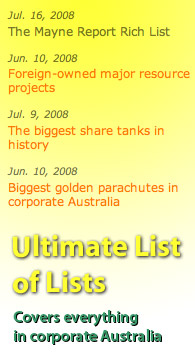Sporting MP's, Murdoch, foreign-owned assests, Babcock AGM
July 22, 2008
Here are Stephen Mayne's six stories from the Crikey edition on Monday, 29 May, 2006.
12. Another sports star tries his hand at politics
By Stephen Mayne
Australia's goalkeeper in the 1974 World Cup, Jack Reilly, has today become the latest in a long line of sports stars to try his hand at politics.
Start-up party People Power this morning announced Reilly will be its lead candidate in the reconstituted Victorian upper house at this year's state election.
Reilly is now a professional director but was previously a Deputy Secretary of the Victorian Treasury and also ran a listed money market business before selling it for a tidy sum shortly before the 1987 stock market crash.
We've never seen a prominent soccer figure try politics before but we've also never seen such passion for the beautiful game in Australia with the World Cup starting on 7 June, so it will be interesting to see how Reilly's political entry plays out.
Given Australia's world leading obsession with sport, it is time for Crikey to build up a comprehensive list of sports stars who tried their hand at politics over the years, so here are 13 names to kick it off:
Tony Benneworth: Former Tasmanian Sheffield Shield cricketer who represented the Liberals in Tasmania and was the unsuccessful federal candidate for Bass in 2001
Ron Clarke: Olympic running legend who is now independent Gold Coast mayor
Phil Cleary: working class VFA legend who won Bob Hawke's seat of Wills as an independent in 1992
Damian Drum: the tough Geelong defender and Fremantle Dockers coach is now an upper house MP for the National Party in Victoria.
Pat Farmer: the ultra-marathon runner is the Federal Liberal member for Macarthur.
Dawn Fraser: Olympic swimming legend won the NSW state seat Balmain as an independent in 1988
Justin Madden: Former Carlton premiership ruckman was the Victorian Labor Minister in charge of the Commonwealth Games
Russell Mark: the Olympic shooting gold medallist was preselected as the star Liberal candidate for the Federal seat of Ballarat in 2001 but then pulled out
Kirstie Marshall: Winter Olympics gold medallist and now the Labor MP for Forest Hill in the Victorian Parliament
Sir Hubert Oppenheimer: Cycling legend who went on to be Minister for Shipping, Transport and Immigration in the Menzies and Holt governments
Maurice Rioli: Norm Smith medallist for Richmond in the losing 1982 grand final and then in 1992 won Arafura for the ALP in the NT parliament
Nigel Smart: Adelaide Crows premiership player who unsuccessfully ran for the SA Libs in Norwood at this year's state election
Bill Sykes: Former Fitzroy AFL footballer who won back Benalla for the National Party at the 2002 Victorian election
Send all corrections and additions to smayne@crikey.com.au, although we doubt it will finish up as big as our journalists in parliament list.
Disclosure: Stephen Mayne is seriously considering running for People Power at the Victorian election but could also go independent.
14. The Murdoch money funding the lefty Australia Institute
By Stephen Mayne
The Prime Minister didn't hold back on Clive Hamilton's Australia Institute yesterday when he had the following exchange over uranium and nuclear power with Barrie Cassidy on Insiders:
Cassidy: But just the other day, the Australia Institute circulated a map that had no real status, and yet the media ran with that and local mayors were outraged. That's what you're up against?The Murdoch press houses some of Australia's leading climate change sceptics – presumably reflecting Rupert's personal anti-Green view – but his sisters don't all toe the Sun King's line, especially Anne Kantor, whose entry in the latest BRW Rich List contains the following:
Howard: Yeah, well, I know, but Barrie, is that kind of behaviour going to be allowed to run the country? I mean, you people quite rightly criticise governments that take flight in the face of cheap populism like that. Well, I'm not going to. And everybody knows that that was a stunt by a left-leaning institute. We all know that.
The Kantor family is known for making contributions to charity, but this year it has also contributed to the environment debate by starting a new research organisation. Eve Kantor (Anne's daughter) and her husband, Mark Wootton, donated $10 million in late 2005 to the left-leaning The Australia Institute to establish The Climate Institute, a non-profit organisation to serve as a bridge between policy-makers and scientists. The organisation will draw up a five-year plan to alert the public the threats posed by global warming.Michael Baume's self-serving column in The AFR this morning claimed that Rupert "is known to be very concerned about the findings of the Lowy poll (that 68% of Australians thought that Australia's foreign policy took too much notice of America)." Baume went on to directly blame Clive Hamilton's outfit:
Naturally, self-proclaimed university experts, often in association with left wing think-tank the Australia Institute, played their part in the scare campaign that convinced half our population that the free-trade agreement would be bad for Australia.Anne Kantor was apparently the only person openly celebrating during a family function at Dame Elisabeth Murdoch's Cruden Farm on the night Jeff Kennett was defeated. After all, Rupert's mum erects Liberal posters on the property during most election campaigns and Rupert's brother-in-law, John Calvert-Jones, succeeded Malcolm Turnbull as Treasurer of the Liberal Party.
However, it's one thing simply to vote Labor, but altogether something else to start bankrolling left wing think tanks that promote anti-Americanism and Green issues, although the original press release doesn't highlight the direct Murdoch family connection. BRW reckons the Kantor family is worth $314 million and it must make Rupert go bananas to think that some of the $600 million he paid to his sisters between 1991 and 1999 is being used this way.
22. Where's the Australian nationalism on foreign-owned assets?
By Stephen Mayne, patriotic Aussie capitalist
The front page lead in The Financial Times on Friday detailed moves by Russia to renegotiate the terms with foreign investors including Exxon-Mobil and Shell in the giant Sakhalin oil and gas projects. Nationalisation has been a feature of the Putin regime and we've also seen Bolivia recently move to nationalise its energy assets and South Korea extract huge donations from exiting foreign investors who snapped up trophy assets during its 1997 financial meltdown.
Elsewhere in The FT on Friday, a feature on Indonesia included the following line:
The Indonesian government is not alone in complicating life for mining companies as developing countries from Latin America to Mongolia increasingly seek a greater share of their mineral resources.It's an interesting question for Australian politicians, given that we have the highest proportion of foreign ownership of our assets of any developed country in the world after New Zealand. Today Tonight and 60 Minutes have been cranking up the coverage about guest workers and immigration, but what about foreign capital?
Truth be known, the huge profits being shipping offshore by foreign energy and mining companies is now close to the biggest single contributor to our appalling current account deficit.
Without wishing to be xenophobic, the WA government's sweetheart deal with London-based Rio Tinto over the Shovelanna iron ore deposit and recent cuts in royalty payments for the mining giant goes strongly against the global trend to push for a greater local share of the profits.
This is why we are putting together the first comprehensive lift detailing ownership and royalty arrangements for every Australian resource project worth more than $1 billion. Today's five new entries are as follows:
Yandi: Australia's biggest iron ore mine is owned as follows: BHP Billiton 85%, Itochu Minerals 8%, Mitsui Iron 7%. 2005 production of 35.66 million tonnes was worth $2 billion and this will rise again with the latest 19% increase in contract prices so the mine is clearly worth several billion dollars and it is 34% Australian owned. WA taxpayers pocket a 3.75% royalty worth about $75 million a year.
Mt Newman: Australia's second biggest iron ore project is 85% owned by BHP Billiton, 10% by Mitsui-Itochu Iron and 5% by Itochu Minerals. 2005 production of 25.74 million tonnes were worth $1.5 billion, so the mine is worth at least $3 billion and Australian ownership is 34%. WA taxpayers pocket a 3.75% royalty worth about $56 million a year.
Yandicoogina: Rio Tinto's biggest Australian iron ore mine in the Pilbara has a designed production capacity of 20 million tonnes per annum of fines, but is undergoing an expansion to 36 million tonnes. At the 2005 price of about $58 a tonne, this produces revenue of almost $1.2 billion for London-based Rio which is about 30% owned by Australian investors. The 3.75% annual royalty payment generates about $45 million a year for WA taxpayers, but the mine is worth at least $4 billion for Rio Tinto shareholders.
Argyle Diamond Mine: world's biggest diamond mine, owned by Rio Tinto which is London-based but 30% Australian owned. Royalty cut from 7.5% to 5% from January 2006 in exchange for $1 billion under ground expansion.
Mt Isa Mines: one of the few places in the world where the four minerals – copper, zinc, lead and silver – are found and mined in close proximity. Owned by Swiss-based and London-listed Xstrata since the MIM takeover in 2001, Mt Isa is now a bonanza with annual production capacity of 5.1 million tonnes of zinc/lead and 6.2 million tonnes of copper which produces revenue of almost $1 billion a year. Queensland royalty take is about $50 million a year.
24. Babcock sails through its second AGM
By Stephen Mayne, owner of 77 B&B shares
Despite some pre-publicity suggesting institutional rumblings, Babcock & Brown got through its second AGM with no meaningful opposition to its pay or board, although we did manage to slug it out for more than two hours at the Four Seasons in Sydney on Friday.
The proxy advisory firms ISS and CGI, which often play the role of kingmaker at AGMs, apparently took issue with a couple of resolutions but didn't muster much support, although this largely reflects the fact that 47% of B&B's shares are still owned by current and former executives.
Whilst John Singleton's STW Holdings copped a 44.5% protest vote (62.78 million proxies in favour and 50.34 million against) over its remuneration report on Thursday due to concerns about CEO Russell Tate's pay structure, Babcock was applauded for comprehensively explaining how its lucrative pay system works.
Macquarie Bank will certainly take heart that the company with Australia's second fattest pay packets got through its first remuneration report vote with just 3.47% of the directed proxies against.
Given that the business press routinely fails to report voting outcomes, these were the three most opposed B&B resolutions:
| Resolution | Proxies in favour | Proxies against | Primary vote in favour |
| Re-election of James Fantaci |
87.98m | 12.49m | 87.57% |
| Martin Rey's $250,000 options |
72.32m | 2.6m | 96.58% |
| Remuneration report | 96.8m | 3.43m | 96.53% |
You've got to feel a little sorry for Fantaci, who runs the North American operation out of New York and was the company's seventh employee when he joined 25 years ago. He's joined the rare "re-elected with less than 90% support" club because Babcock still doesn't have a clear majority of independent directors.
The addition in April of new independent Joe Raby, the former CEO of US investment bank Donaldson Lufkin Jenrette before it was sold to CS First Boston for $US11.5 billion in 2000, is quite a coup for Babcock although it still has an executive chairman in Jim Babcock and there is some dispute about whether deputy chairman Elisabeth Nosworthy is genuinely independent given her deep affiliation with various Babcock associates.
The Australian Shareholders Association had a big whack at Martin Rey's options, mainly because they were priced at $17.25 – the recent book build price when $330 million was raised by staff selling down from 54% to 47%. Sure, the stock is now up around $20 after Friday's profit upgrade, but giving an executive 250,000 performance-related options at $17.25 is a drop in the bucket compared with previous hurdle-free issues and the massive cash bonuses on offer.
For instance, CEO Phil Green was issued 800,000 hurdle-free options at $5 the day before the float in October 2004. I had a decent whack at this during the debate about the remuneration report and later directly asked Ernst & Young auditor Mark O'Sullivan whether it was a "material mis-statement" to value them at $1.27 a share or $1.02 million in total when calculating that Green's overall package was worth $10.3 million in 2004.
Based on Friday's close of $19.97, these 800,000 options are actually worth $12 million so Green's 2004 salary package is currently valued at $21.3 million – more than double what the 2005 annual report states, even though the auditor didn't sign off until 30 March, 2006. Both remuneration committee chairman Ian Martin and O'Sullivan hid behind the lame accounting standard requiring historical accounting on the day of issue in defending this material under-statement of the CEO's package.
With up to $1 billion in option valuation understatement across our top 100 companies over the past five years, it really is time for Peter Costello to step in and change the law because boards and auditors are getting away with signing accounts that, when it comes to truly revealing what a CEO is paid, are often a crock.
25. Independence and transparency in the Babcock satellites
By Stephen Mayne, small investor in four Babcock vehicles
Babcock & Brown's pugnacious CEO Phil Green blithely told the press after Friday's AGM that his company would float "four or five" new satellites over the coming year, in keeping with the pace he set in 2005.
It is the myriad fees coming to Babcock & Brown from these various vehicles which have driven its strong profits and share price since the 2004 float, but the performance has started to wobble in recent months, particularly after it was revealed Babcock & Brown Wind had paid a whopping $33 million in performance fees for the December half. As some shocked commentators pointed out at the time, cash flow was only $15.8 million for the half, so investors copped a net loss of $18.3 million after the fee raid.
No independent directors or institutional investors should tolerate gouging, so I asked the Babcock board on Friday what sort of protection they had in place to stop themselves from being sacked as manager.
After being told Macquarie Bank chairman David Clarke usually says "nothing, just our good performance" when asked a similar question, Phil Green adopted that strategy. But is that really the case? What would happen if a group of shareholders petitioned an EGM to sack Babcock as manager? Are all the circumstances in the public arena? There may be some interesting developments on this front in the months ahead.
When it came to the re-election of Babcock independent director and long-standing ASX director Michael Sharpe, I asked if he took an interest in the manager termination provisions in various Babcock satellites and whether he was satisfied with the level of disclosure. Acting chairman Elizabeth Nosworthy claimed Sharpe was wasn't on the board of any satellites so he wasn't responsible but Sharp then went on the public record saying he is "extremely interested" in such disclosures because "it goes to our reputation" and he is satisfied "our transparency is of a high standard".
Babcock, just like Macquarie Bank, pushes the corporate governance envelope with these satellites because there are huge conflicts of interest, countless related party transactions and boards which are not exactly full of genuinely independent directors. For instance, I reckon much of Friday's profit upgrade will come from fat fees that will flow every which way after Babcock & Brown Capital's $8 billion agreed bid for Irish telco Eircom.
Here is a summary, ranked from worst to best, of how the various Babcock vehicles have performed and a list of the independent directors.
Babcock & Brown Capital: Floated in Feb 2005 with $1 billion raised at $5 a share. Now just $4.03 after $8 billion Eircom tilt.
Independent directors: Robert de Crespigny (chair), Kerry Roxburgh and Bill Waivish
Babcock & Brown Infrastructure: Stable for the year, but down from $1.87 last September to a recent low of $1.46 before Phil Green bought.
Independent directors: David Hamill (chair), Leigh Hall, Andrew Tyndale and Barry Upson
Babcock & Brown Wind: $1.40 float price in November 2005, then tanked from high of $1.93 to $1.60 after $33 million in fees ripped out.
Independent directors: Douglas Clemson, Tony Battle, Mr Nils Andersen (Babcock executive Peter Hofbauer is chairman)
Everest Babcock & Brown: issued 60 million shares at $5 to raise $300 in May 2005. Now $5.65 after restructure announced last week.
Independent directors: Trevor Gerber (chair), Kerry Roxburgh, Keith Ince and Olev Rahn
Babcock & Brown Japan: Floated as $1 units in April 2005, now $1.75
Independent directors: Allan McDonald (chair), Paula Dwyer and John Pettigrew
Babcock & Brown Environment: Shares up substantially but hard to follow its various early incarnations
Independent directors: JE Graham, Tony Leibowitz and Barry Murphy (Babcock CEO Phil Green is chairman)
Babcock & Brown: rocketed from $5 float price in October 2004 to $19.97 on Friday:
Independent directors: Elizabeth Nosworthy (dep chair), Michael Sharpe, Joe Roby and Ian Martin
As you can see, some vehicles have independent chairs and others don't. However, the independence of people like Babcock & Brown Capital chair Robert de Crespigny is open to debate given he and Babcock together went the sword on Primelife founder Ted Sent.
Similarly, is Multiplex chairman Allan McDonald a genuinely independent chairman of Babcock & Brown Japan given the large number of property deals that the two firms do together? At the end of the day, both Babcock & Macquarie need to pay reputable independent directors who will sign off on their controversial dealings. Who has the better list is an issue we'll explore in the days ahead.
26. How to build a killer board
By Stephen Mayne
Crikey subscribers in Brisbane are welcome to come to this event on Wednesday night to discuss a question that challenges many organisations ranging from my local kinder to BHP-Billiton – how to build a killer board.
The Australian Institute of Company Directors (AIDC) and The Churchill Club, a new group promoting innovation and entrepreneurialism, ran a similar event in Melbourne earlier this year and had good feedback so the roadshow is heading to Brisbane, complete with yours truly as moderator, despite my record as Australia's most rejected candidate.
The panellists include telco veteran turned professional director Terry Cutler, Boeing Australia MD David Gray, University of Queensland deputy vice-chancellor Paul Greenfield and corporate governance and strategy consultant Gavin Nicholson.
We'll stick around for a few drinks at the swanky Polo Club afterwards so members of the Crikey army are encouraged to shell out the $66 and come along for the debate and then an informal pub night of sorts after the formalities are done.
In terms of answering the proposition, here are a few thoughts:
- Don't bother with advisory boards – do the Full Monty or hire a few consultants
- Be very wary of allowing venture capitalists onto your board
- A token woman is out – have none or at least two
- Quality control is vital because there's thousands of dud wannabe directors out there
- Find a chairman mentor and let them help put together the full board
- Always have a meal and some socialising with board meetings
- It's not just about industry experience and experts – they can be hired as consultants
- Have an odd number of five, seven or nine so there aren't deadlocked votes
- Get a good spread of skills – ie one accountant, one lawyer, one marketer, one IT guru
- Try to avoid out-of-towners – directors should all be based in the head office city if possible
Copyright © 2024 The Mayne Report. All rights reserved






















